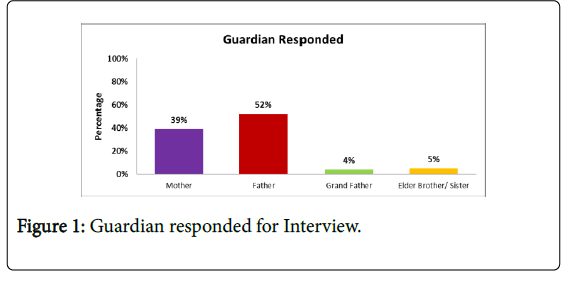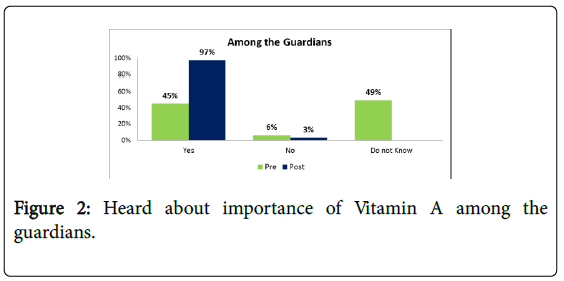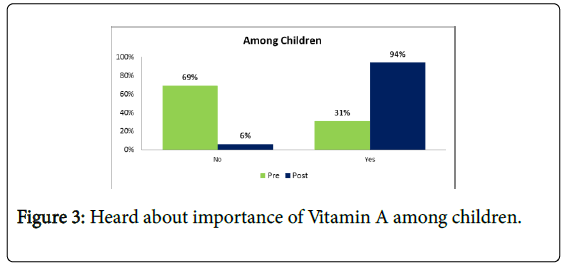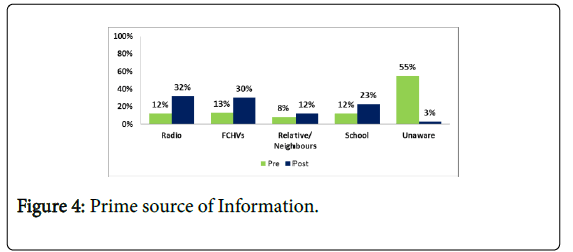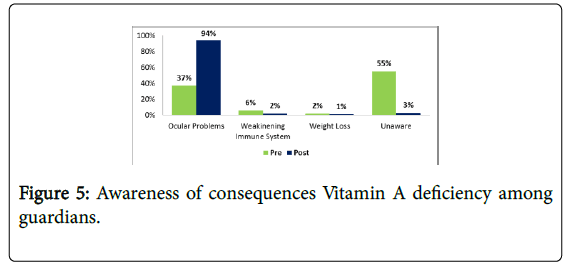Effectiveness of Planned Eye Health Education Programme to Create Awareness and Practice Regarding Vitamin A Intake among Caregiver and Their Children in Sunsari District of Nepal
Received: 26-Jan-2019 / Accepted Date: 16-Apr-2019 / Published Date: 23-Apr-2019
Abstract
Vitamin A deficiency is one of the most significant causes of preventable childhood blindness. The objective of the study was to assess the effectiveness of planned eye health education programme to create awareness and practice regarding Vitamin A intake among parents and their children in Koshi rural municipality of Sunsari district in Nepal. The method used for this study was quasi experimental one group pre-test and post-test research design. Based on the objectives and hypothesis the data were analyzed by various statistical tests. Analysis of data showed that there is significant difference between pre and post-test knowledge (p value-<0.05). Hence it is statically interpreted that the planned eye health education programme to create awareness and practice regarding Vitamin A intake among parents and their children was effective.
Keywords: Planned eye health education programme; Importance of vitamin A; Sunsari district; Pre-post-test; School going children; Nepal; Koshi rural municipality
Keywords
Planned eye health education programme; Importance of vitamin A; Sunsari district; Pre-post-test; School going children; Nepal; Koshi rural municipality
Introduction
Most of a child’s early learning comes through vision. This makes eye health a very important aspect of children’s development and overall wellbeing. However children’s eye health is rarely mentioned in the child health agenda and remains a neglected area despite the immense implications on an individual child, the family and broader society.
Vitamin A deficiency is a public health concern in more than half of all countries, and most of the countries affected are in Africa or southeastern Asia [1,2]. However, it is estimated that, globally, 190 million children under five years of age are affected by vitamin A deficiency [1]. These children suffer an increased risk of visual impairment (night blindness), illness and death from childhood infections such as measles and those causing diarrhea.
The combination of childhood underweight, micronutrient deficiencies (iron, vitamin A and zinc) and suboptimal breastfeeding is responsible for 7% of deaths and 10% of the total disease burden [3]. Vitamin A deficiency alone is responsible for almost 6% of child deaths under the age of 5 years in Africa and 8% in South-East Asia [3]. Vitamin A supplementation in children 6-59 months of age living in developing countries is associated with a reduced risk of all-cause mortality and a reduced incidence of diarrhea [4]. Currently, an estimated 250 million preschool children in the world have vitamin A deficiency, and 250 000 to 500 000 of such children go blind every year. Of the children who go blind, half die within one year of losing their eyesight [1].
Provision of high doses of vitamin A every 6 months until the age of 5 years was based on the principle that a single, large dose of vitamin A is well absorbed and stored in the liver, and then mobilized, as needed, over an extended period of time. A dose of 100 000 International Units (IU) in infants 6-11 months of age and 200 000 IU in children 12-59 months of age is considered to provide adequate protection for 4-6 months. In areas where vitamin A deficiency is a public health problem, routine vitamin A supplementation is recommended in infants and children 6-59 months of age as a public health intervention, and has been shown to reduce the risk of all-cause mortality by 30% [2,5].
Sunsari district is one the prime district of Nepal. Koshi Rural Municipality is one of the backward rural municipality of Sunsari districts where majority of Mushar people resides and about 30% of the children are malnourished [6].
The level of knowledge affects the level of coverage of vitamin A. Comprehensive control of vitamin A deficiency should include strategies for dietary improvement and food fortification as well. To combat the deficiency of vitamin A in community, awareness of their importance and their source plays a vital role [1].
Eye health awareness among general population is very poor in Nepal, the least of it being in the rural and remote areas. Most people in rural areas have deep-rooted belief in spiritual and ancient ways of healing diseases including eye problems, and still regard blindness as an incurable curse from god.
A study was conducted to assess the effectiveness of planned eye health education programme to create awareness and practice regarding vitamin A intake among parents and their children in selected Koshi rural municipality of Sunsari district of Nepal in 2018.
Objective
• To assess the change in knowledge about Vitamin A among both parents and children
• To assess the coverage of planned eye health education activities
• To analyze the feeding habits of Vitamin A rich foods among school going children
• To assess the effectiveness of planned eye health education to create awareness and practice regarding vitamin A intake among parents and their children.
Methodology
A single group pre post (quasi experimental) study conducted in rural Koshi Gaupalika of Sunsari district of Nepal. Planned eye health education activities includes Orientation on early eye health seeking behavior change to the 100 female community health volunteers (FCHV), School wall painting of saag bahadur-bhaat bahadur (Motivating to eat vitamin A rich foods daily) along with self-assessment vision chart, Sensitization program for parents, students and teacher in school, Broadcasting of Children eye care message in local F.M., conduction of drawing competition on children eye health and conduction of drama in school premise. The population and sample for the study were grade 1 to 10 school going children and their parents. The sampling technique for the study were two stage sampling i.e., firstly, 30 schools were selected among 100 interventional study through simple random sampling, secondly, 7 students were selected from each school through conventional sampling. Total sample size for the study was 219. The interviews were taken at the home of selected school going children. The validated questionnaire had 3 section i.e., socio-demographic section, section for parents and section for children. The pretest was conducted before the intervention and post test was conducted after one month of completion of planned eye health education activities among the same respondents. The study was conducted from December, 2017 to June, 2018. The data were analyzed through SPSS 20.0.
Result
Socio-demographic characteristics
219 children participated in the study for both pre and posttest. Mean age of the children was 9.4 years and median child attending class was 4th standard. More than 60 % of the children were boys. More than 90% of the guardian responded were either mother or father which closely related to the care of their children.
Heard about importance of Vitamin A
Above figure stated that only 45% of the guardians were aware of the importance of Vitamin A and 55% of the guardian had not heard about the importance of Vitamin A before implementation of any form of planned eye health education activities. After the implementation of planned eye health education programme such as School wall painting, drama programme, sensitization programme, drawing competition, FCHVs training and broadcasting of eye health message through radio, had increased to 97% among the guardians of children (Figure 1).
Similarly among children, only 31% of the children were aware of the importance of Vitamin A whereas 69% were not before implementation of planned eye health education programme. After the intervention of planned eye health education programme, increased to 94% among the children (Figures 2 and 3).
Prime source of Information
The radio, FCHVs, School and relative/neighbors were the prime source to diffuse the awareness on importance of Vitamin A among parents. Radio accounted for 20%, FCHVs for 17% & school wall painting for 11% change in awareness level improvement (Figure 4).
Awareness on consequences of vitamin A deficiency
The awareness on consequences of Vitamin A deficiency can lead to ocular problems had increased from 37% to 94% whereas could lead to weakening immune system or weight loss was in decreasing trends (Figure 5).
The consumption of vitamin A rich foods were in increasing trend i.e., green leafy vegetable consumption increased from 70% to 90%, Pumpkin consumption from 10 to 18% (Table 1).
| Food Items | Pre | Post |
|---|---|---|
| Green Leafy Vegetables | 70% | 90% |
| Pumpkin | 10% | 18% |
| Carrot | 14% | 44% |
| Papaya/ Mango | 9% | 34% |
| Egg | 19% | 44% |
| Meat | 14% | 27% |
| Milk Product | 51% | 46% |
Table 1: Last day consumption of Vitamin A rich foods.
Overall the awareness on importance of Vitamin A in post situation increased about 4 times than pre situation among guardian of children due to planned health education programme, which is significant. (Paired T-test, p value <0.05).
Discussion
This study has attempted to assess the effectiveness of planned eye health programme to create awareness and practice regarding Vitamin A rich foods intake among caregiver & their school going children in eastern Nepal.
Finding reveals that only 45% caregiver and 69% of the school children were aware of the importance of Vitamin A in a preintervention, which is very similar to study conducted in Dominica Republic people that Caregiver knowledge regarding vitamin A was low in all villages regardless of differences in socio-economic status and level of education. But, a study conducted in Nepal showed that more than 90 % of the Nepalese mothers were aware of it which is contrary to this study in pre intervention. But post intervention eye health education activities, 97% of the caregivers & 94% of the children were aware on importance of Vitamin A which is very much similar to study conducted by Rahman and Sapkota.
Finding for prime source of information showed that radio, female community health volunteers (FCHV), school level activities such wall painting, sensitization programme has played great role in creating the awareness on importance of Vitamin A among caregiver which is very similar to study conducted in Nepal. This pre-post study showed that radio accounted for 20%, FCHVs for 17% and school wall painting for 11% change in awareness level improvement.
The research has also demonstrated that more than 96% of the children liked to take Green Leafy Vegetables (GLV) which is very good sources of vitamin A which is very much coherent with study conducted in Nepal. But a study which was conducted in Mumbai, India Kothari et al., 2001 illustrated that 23.1% of the children did not like to eat GLV. Though the place are not same and culturally a little different but still awareness on vitamin A rich foods in Nepal is more than Indian situation. This study showed that last day consumption of Vitamin A rich foods such as green leafy vegetables, carrot, pumpkin etc. has increased significantly post intervention. Overall it shows that due to planned eye health education programme, the level of awareness has increased thrice after post intervention.
Conclusion
In conclusions, like many other under developed and developing countries in the south and south-east Asia and in Africa the vitamin A deficiency disorder is a major public health problem in Nepal. Vitamin A deficiency was found to increase both childhood morbidity and mortality. A planned eye health education programme can enhance level of awareness and practice of consuming vitamin A rich foods, efforts from the Government and the local and international NGOs are required to improve such public health conditions in Nepal. Awareness on consequences of vitamin A deficiency has increased towards ocular problem, but need to incorporate other significant consequences of Vitamin A deficiency coherently.
References
- Susan C, Shashidhara YN, Kurian N (2014) Awareness of vitamin a supplementation among mothers of under-five children in selected urban and rural areas. Int J Sci Res 3: 1-3.
- Global Health Risks (2009) Mortality and burden of disease attributable to selected major risks. World Health Organization, Geneva.
- WHO (2011) Vitamin A supplementation in infants and children 6–59 months of age. Geneva.
- Nutrition (2014) Scaling up vitamin a supplementation in india evidence and lessons learned from 15 major states in India.
- Ministry of Health (2016) Nepal demographic and health survey 2016. Kathmandu, Nepal.
Citation: Anwar A, Singh SK, Thakur SK (2019) Effectiveness of Planned Eye Health Education Programme to Create Awareness and Practice Regarding Vitamin A Intake among Caregiver and Their Children in Sunsari District of Nepal. J Community Med Health Educ 9:654.
Copyright: © 2019 Anwar A, et al. This is an open-access article distributed under the terms of the Creative Commons Attribution License, which permits unrestricted use, distribution, and reproduction in any medium, provided the original author and source are credited.
Share This Article
Recommended Journals
Open Access Journals
Article Usage
- Total views: 2579
- [From(publication date): 0-2019 - Apr 04, 2025]
- Breakdown by view type
- HTML page views: 1847
- PDF downloads: 732

